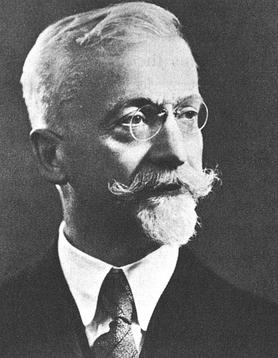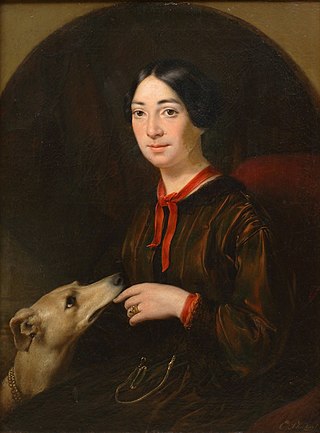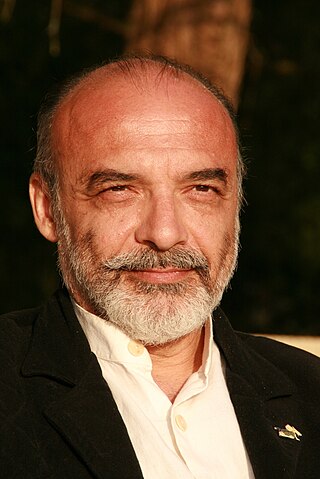
In folklore, a werewolf, or occasionally lycanthrope, is an individual who can shape-shift into a wolf, or especially in modern film, a therianthropic hybrid wolf-like creature, either purposely or after being placed under a curse or affliction, often a bite or the occasional scratch from another werewolf, with the transformations occurring on the night of a full moon. Early sources for belief in this ability or affliction, called lycanthropy, are Petronius (27–66) and Gervase of Tilbury (1150–1228).

Jules Henri Poincaré was a French mathematician, theoretical physicist, engineer, and philosopher of science. He is often described as a polymath, and in mathematics as "The Last Universalist", since he excelled in all fields of the discipline as it existed during his lifetime. Due to his scientific success, influence and his discoveries, he has been deemed "the philosopher par excellence of modern science."

Paul Abraham Dukas was a French composer, critic, scholar and teacher. A studious man of retiring personality, he was intensely self-critical, having abandoned and destroyed many of his compositions. His best-known work is the orchestral piece The Sorcerer's Apprentice, the fame of which has eclipsed that of his other surviving works, largely due to its usage in the 1940 Disney film Fantasia. Among these are the opera Ariane et Barbe-bleue, his Symphony in C and Piano Sonata in E-flat minor, the Variations, Interlude and Finale on a Theme by Rameau, and a ballet, La Péri.

Charles-Marie Gustave Le Bon was a leading French polymath whose areas of interest included anthropology, psychology, sociology, medicine, invention, and physics. He is best known for his 1895 work The Crowd: A Study of the Popular Mind, which is considered one of the seminal works of crowd psychology.

Élie Joseph Cartan was an influential French mathematician who did fundamental work in the theory of Lie groups, differential systems, and differential geometry. He also made significant contributions to general relativity and indirectly to quantum mechanics. He is widely regarded as one of the greatest mathematicians of the twentieth century.
Clinical lycanthropy is a rare psychiatric syndrome that involves a delusion that the affected person can transform into, has transformed into, or is, a non-human animal. Its name is associated with the mythical condition of lycanthropy, a supernatural affliction in which humans are said to physically shapeshift into wolves. The term is used by researchers mostly in the broader sense of transformation into animals in general, that, strictly speaking, is described as zoanthropy.

Metoposcopy is a form of divination in which the diviner predicts personality, character, and destiny, based on the pattern of lines on the subject's forehead. It was in use in the Classical era, and was widespread in the Middle Ages, reaching its zenith in the 16th and 17th centuries.

A werecat is an analog to "werewolf" for a feline therianthropic creature.

Charles Adrien Casimir Barbier de Meynard, born at sea on a ship from Constantinople to Marseille, was a nineteenth-century French historian and orientalist.

The Four Sergeants of La Rochelle were a group of French soldiers who plotted to overthrow the French monarchy of the Bourbon Restoration. Sergeants Bories, Pommier, Gobin and Raoulx were associates of the revolutionary Charbonnerie, a French secret society modelled after the Italian Carbonari. After being arrested for political conspiracy and membership of an outlawed organization, the four were guillotined in Paris on 21 September 1822.
In carbohydrate chemistry, the Lobry de Bruyn–Van Ekenstein transformation also known as the Lobry de Bruyn–Alberda van Ekenstein transformation is the base or acid catalyzed transformation of an aldose into the ketose isomer or vice versa, with a tautomeric enediol as reaction intermediate. Ketoses may be transformed into 3-ketoses, etcetera. The enediol is also an intermediate for the epimerization of an aldose or ketose.
Alain Demurger is a French historian, and a leading specialist of the history of the Knights Templar and the Crusades.

Émile Michel Hyacinthe Lemoine was a French civil engineer and a mathematician, a geometer in particular. He was educated at a variety of institutions, including the Prytanée National Militaire and, most notably, the École Polytechnique. Lemoine taught as a private tutor for a short period after his graduation from the latter school.

Roc-aux-Sorciers is an Upper Paleolithic rock shelter site dating to the mid-Magdalenian cultural stage, ca 14,000 yBP, made famous by its relief wall carvings. The site is in the French commune of Angles-sur-l'Anglin, in Vienne. The name 'Sorcerers' Rock', with its suggestions of pagan rendez-vous, was applied to the site long before the wall-carvings were discovered.
Qigang Chen is a Chinese-French composer who has lived in France since 1984 and obtained French citizenship in 1992.

Le dernier sorcier is a chamber opera in two acts with music composed by Pauline Viardot to a French libretto by Ivan Turgenev. It was first performed privately on 20 September 1867 at the Villa Turgenev in Baden-Baden and received its first public performance at the Court Theatre in Weimar on 8 April 1869. The story revolves around Krakamiche, an old and once-powerful sorcerer whose presence in the woods has upset the elves living there, and a romance between the sorcerer's daughter Stella and Prince Lelio, whose marriage comes about through the intervention of a Queen of the Elves.
Jacques de Chevanes was a French Capuchin polemicist. He used the pseudonyms Jacques d'Autun and Saint-Agran.

In mythology and literature, a werewoman or were-woman is a woman who has taken the form of an animal through a process of lycanthropy. The use of the word "were" refers to the ability to shape-shift but is, taken literally, a contradiction in terms since in Old English the word "wer" means man. This would mean it literally translates to "man-woman".
Nicole Jacques-Lefevre, also known as Nicole Jacques-Chaquin, is a Professor of Literature at the University of Picardie Jules Verne who specialises in the study of demonological texts of the Enlightenment in the eighteenth century including werewolves and lycanthropy.

Édouard Brasey is a French novelist, essayist, scriptwriter and story-teller born on 25 March 1954. Author of more than seventy works, many of which have been translated into English, Russian, Japanese, Spanish, Portuguese and Italian. He specialises in the themes of the esoteric, fables, legends and fantasy. He won a prize of Imaginales in 2006 for La Petite Encyclopédie du Merveilleux, and a prize Merlin in 2009 for his novel La Malédiction de l'Anneau. Subsequently, he has become essentially a novelist, notably published by Calmann-Lévy. His historical-esoteric thriller that was published in 2013, Le Dernier Pape, anticipated the abdication of Benoît XVI.














